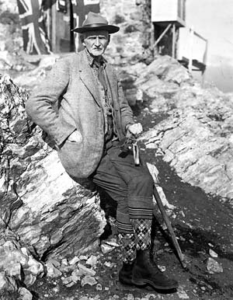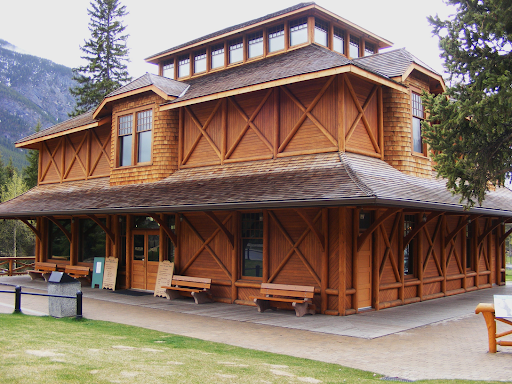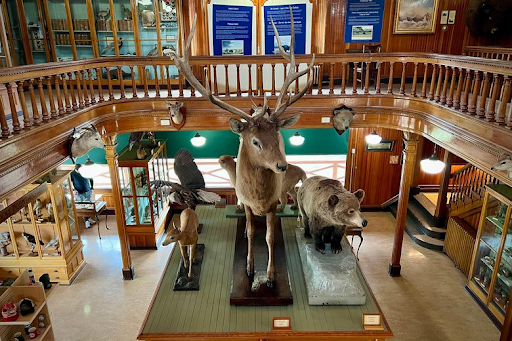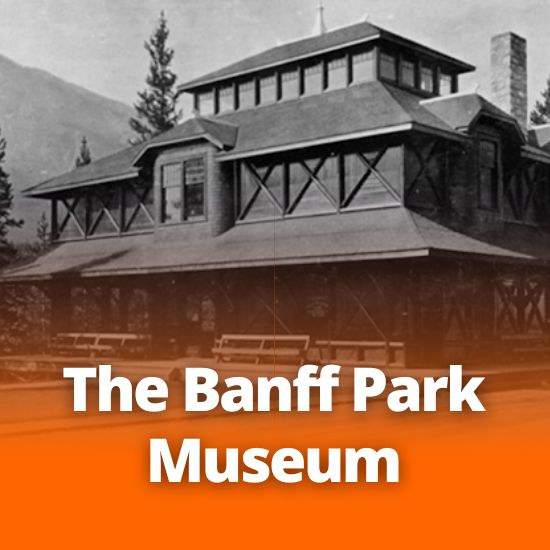
The Banff Park Museum
Off Banff Avenue, there is a log building: the Banff Museum. Not only a house for more than 5,000 “vintage botanical and zoological specimens” but a national historic site to boot!
The Banff Park Museum shows us how natural history was understood in Canada near the end of the Victorian era. – Parks Canada
Built in 1903, the museum is the oldest surviving federal building in any Canadian national park and the oldest national history museum in western Canada.
Location and Entry
Address
91 Banff Avenue, Banff, AB, T1L 1A9
Did you know that entry fees to national parks and historic sites are used to support visitor services and facilities. Every time you visit, you’re investing in the future for future generations to enjoy these sites!
Currently, as of April 2024, the entrance fees to the museum stand as:
Adult (18-64): $4.50
Senior (65+): $4.00
Youth (6-17): Free (includes children younger than 6)
Commercial group (per person): $3.83
History
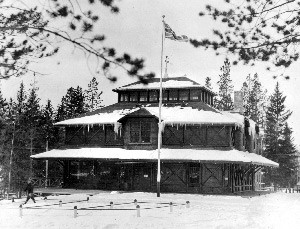
The museum came to be from the old Natural History Branch (NBH) of the Geological Survey of Canada. In February 1985, a shipment of 1,340 mounted and labeled specimens arrived including animal taxidermy as well as 814 plants and 201 mineral samples.
A representative of the National History Branch, John Macoun, described the specimens as “an almost complete representation of the birds and flowering plants found within the limits of the park.”
The NBH had been developing exhibits for the World Exhibition that took place in Chicago, USA. So not only did the museum receive the natural specimens, but a cornucopia of display furniture from when Macoun’s staff dismantled the Canadian pavilion at the end of the 1893 Exhibition.
Side note, can you imagine being in the 1800s in Chicago, and going to that? I mean, seeing those gorgeous Canadian creatures up close?! When they reached Banff there were 8 mammals, 259 birds, and a turtle! I mean, I think I would’ve been blown away.
The collection continued to grow throughout the years as it inherited more tokens, all documented in a hand book of the museum written by Harlan Smith of the National Museum in Ottawa. But Smith is almost a footnote when compared to Norman Bethune Sanson, and if that name seems familiar it’s because he’s mentioned in our post all about the Banff Gondola, from which you can visit Sanson’s Peak.
Yes, that Sanson.
This grumpy looking man is an incredibly important figure to the natural history registry of Canada. Along with Smith, he actively collected field samples and arranged and expanded the museum’s collection. Curator from 1896-1932 he was so dedicated he continued to volunteer for years after his retirement.
He even personally accompanied King Prajadhipok (or Rama VII) and Queen Rambai Barni of Siam to the top of Sulphur Mountain in 1931, and King George VI to the top of Tunnel Mountain in 1939.
Irreplaceable, no one took his position after he retired and the collection we can visit today is largely a representation of the 1914 era (and Sanson’s dedication).
Construction
While the park museum was first established in summer 1895, it was moved to its current building in 1903.
The log building was designed by John Stocks, an engineer with the territorial public works office, and was constructed by the federal government. It is the oldest surviving building maintained by Parks Canada and is the “largest and most elaborate example of the early phase of park design utilizing decorative cross-log construction.”
The building is recognizable with a distinctive shape (described today as “a railway pagoda”) and “graceful” design which makes use of Douglas Fir and the local setting to support the inherent character of Banff.
Outside, the layering shingled roof surfaces move from the wide veranda eaves to the hip roof to the central lantern (that is, the large part on the top of the roof there with all the windows). The crossed-log veneer walls have protruding shingled bays at the upper level and sets of large windows. It uses a cantilevered truss system to support the second floor, demonstrating the awareness of the demands for natural light and space required of a museum.
Inside, that central lantern allows natural light to reach both the main floor and mezzanine level. It has all wood finish, trim, and detailing, which includes the display cases and other furnishings. All of which, for the most part, are original to the building from 1903. While more recent restoration has allowed the recovery of some elements form time, and insertion of supportive/sympathetic new work (pretty sure they didn’t have ceiling fans in 1903), the evidence of high quality craftsmanship and materials is a visual reminder that the museum has always been meant as a “showpiece” and landmark for Banff.
The museum was declared a National Historic Site of Canada in 1985, and designated as “Classified” in 1986, by the Federal Heritage Buildings Review office to “protect, preserve, and present the museum for present and future generations.”
Exhibits
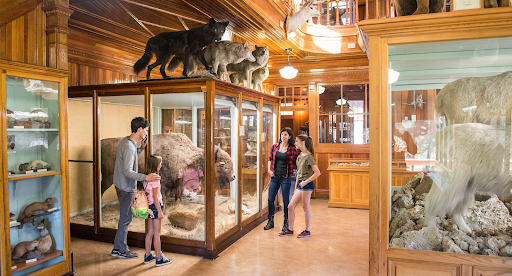
The vintage turn-of-the-century taxidermy collection includes everything from a bear to a bee collected from the park around the early 1900s, and allows a “unique chance” to take a close look at park wildlife. Today, the museum displays more than 5,000 specimens, characteristic of early museum practices of taxidermy. Whether it’s bears or bees, birds or fish, there’s something to sate everyone’s curiosity. (Plus, it’s the safest way to get close to a grizzly without losing your face).
You can also visit the Reading Room, which has a wide collection of books and magazines to peruse. Get comfy in one of their sofas or lose yourself in a deep research dive.
The museum makes sure to emphasize changes in attitudes toward natural resource management over time (i.e. not hunting for sport). And while the building, collection, and grounds have been minutely modified in keeping with modernizing demands, they have been done with awareness of the historical significance of the building and collection.
Have you ever visited the Banff Park Museum, or will you put it on your list or your next trip?
